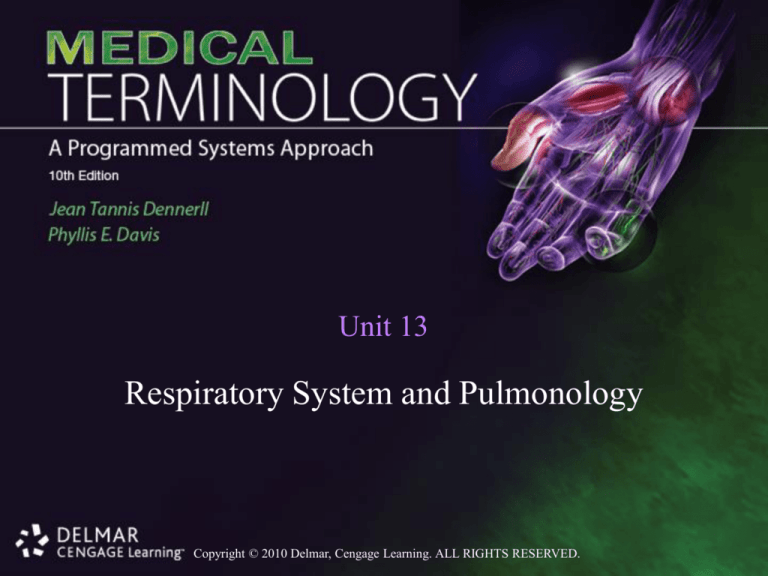
Unit 13
Respiratory System and Pulmonology
Copyright © 2010 Delmar, Cengage Learning. ALL RIGHTS RESERVED.
Respiratory System
• Primary functions:
– Inspiration of oxygen
– Expiration of carbon dioxide
Copyright © 2010 Delmar, Cengage Learning. ALL RIGHTS RESERVED.
Respiratory System
• Movement of air:
–
–
–
–
–
–
Nasal and sinus passages
Pharynx
Trachea
Bronchi
Bronchioles
Alveoli
Copyright © 2010 Delmar, Cengage Learning. ALL RIGHTS RESERVED.
Structures of the Respiratory System
Copyright © 2010 Delmar, Cengage Learning. ALL RIGHTS RESERVED.
Exchange of Gases
1. Oxygen diffuses through alveolar wall into
surrounding capillaries
2. Hemoglobin transports oxygen to cells
3. Carbon dioxide moves from tissues into
bloodstream
4. Carbon dioxide moves into alveoli and is
exhaled
Copyright © 2010 Delmar, Cengage Learning. ALL RIGHTS RESERVED.
Respiratory Combining Forms
Combining form
Meaning
nas/o
nose
rhin/o
nose
pharyng/o
pharynx (throat)
laryng/o
larynx (voice box)
trache/o
trachea (windpipe)
broncho/o
bronchi or bronchus
Copyright © 2010 Delmar, Cengage Learning. ALL RIGHTS RESERVED.
Respiratory Combining Forms
Combining form
Meaning
bronchiol/o
bronchioles
alveol/o
alveoli or alveolus
phren/o or diaphragm/o diaphragm
pulmon/o
lung
pneum/o
air
pneumon/o
lung
Copyright © 2010 Delmar, Cengage Learning. ALL RIGHTS RESERVED.
Lungs
• pneumon/o = combining form
• Examples:
– pneumon/o/pathy = any lung disease
– pneumon/o/rrhagia = hemorrhage of lungs
– pneumon/o/melan/osis = lung disease characterized by
black lung tissue
• melan/o
Copyright © 2010 Delmar, Cengage Learning. ALL RIGHTS RESERVED.
Lung Conditions
• Examples:
– pneumon/itis = inflammation of lungs
– pneumon/ia = acute inflammation of lungs
• Caused by:
– Bacteria, fungi, and viruses
• Treatment:
– Antibiotics
– atel/ectasis = collapsed lung
• Dilated or expanded
Copyright © 2010 Delmar, Cengage Learning. ALL RIGHTS RESERVED.
Lung Procedures
• Examples:
– pneumon/o/tomy = incision into lung
– pneumon/ectomy = excision of part or all of lung
– pneumon/o/centesis = surgical puncture of lung to remove
fluid
– pneumon/o/pexy = surgical fixation or attachment of
prolapsed lung
Copyright © 2010 Delmar, Cengage Learning. ALL RIGHTS RESERVED.
Lungs
• pulmon/o = another combining form for lungs
– Used only in a few words
• Examples:
– pulmon/ary and pulmon/ic = pertaining to lungs
– cardi/o/pulmon/ary = pertaining to heart and lungs
– pulmon/ary valve = heart valve through which blood
travels to lungs
– pulmon/ary embolus = blood clot moving to lung
Copyright © 2010 Delmar, Cengage Learning. ALL RIGHTS RESERVED.
Air
• pneum/o = combining form
– Can also mean lung
• Examples:
– pneum/o/therapy = treatment with compressed air
– pneum/o/meter = instrument that measures air volume in
respiration
• spir/o/meter = instrument that measures lung volume
Copyright © 2010 Delmar, Cengage Learning. ALL RIGHTS RESERVED.
Air
• Examples:
– pneum/o/derm/a = collection of air under skin
– pneum/o/thorax = collection of air in chest cavity
• Air forced into cavity
– pneum/o/py/o/thorax = collection of air and pus in chest
cavity
– pneum/o/hem/o/thorax = collection of air and blood in
chest cavity
Copyright © 2010 Delmar, Cengage Learning. ALL RIGHTS RESERVED.
Breathing
• pne/o = combining form
• -pnea = suffix form
– Used most often
• Normal breathing rate for adults:
– 12 to 16 breaths per minute
Copyright © 2010 Delmar, Cengage Learning. ALL RIGHTS RESERVED.
Breathing
• Inspire
– To breathe in
• Expire
– To breathe out
Copyright © 2010 Delmar, Cengage Learning. ALL RIGHTS RESERVED.
Animation
Click Here to Play Respiration Animation
Copyright © 2010 Delmar, Cengage Learning. ALL RIGHTS RESERVED.
Respiratory Symptoms
Term
Symptom
a/pnea
absence of breathing
dys/pnea
difficult breathing
hyper/pnea
increased rate and depth of breathing
tachy/pnea
rapid breathing
brady/pnea
slow breathing
ortho/pnea
able to breathe only when sitting up
or standing
Copyright © 2010 Delmar, Cengage Learning. ALL RIGHTS RESERVED.
Respiratory Symptoms
Term
hem/o/pty/sis
Symptom
expectorating blood
hyper/ventil/ation excessive movement of air in and out
of lungs
hyp/oxia
cyan/osis
low oxygen levels in organs and
tissues
bluish color due to hypoxia
Copyright © 2010 Delmar, Cengage Learning. ALL RIGHTS RESERVED.
Sputum
• Combination of mucus and other fluids and
substances in respiratory tract
• ptyal/o = combining form for sputum and
saliva
• Examples:
– hemo/pty/sis = coughing up sputum containing blood
– ptyal/o/rrhea = drooling due to excess saliva
Copyright © 2010 Delmar, Cengage Learning. ALL RIGHTS RESERVED.
Nasal Cavity
• nas/o = combining form
• Examples:
– nas/al = pertaining to nose
– nas/itis = inflammation of nasal cavity
– nas/o/scope = instrument used to examine nasal cavity
Copyright © 2010 Delmar, Cengage Learning. ALL RIGHTS RESERVED.
Nasal Cavity
• Examples:
–
–
–
–
nas/o/pharyng/itis = inflammation of nose and pharynx
nas/o/front/al = pertaining to nasal and frontal bone
nas/o/lacrimal = pertaining to nose and lacrimal (tear) duct
epi/staxis = nosebleed
Copyright © 2010 Delmar, Cengage Learning. ALL RIGHTS RESERVED.
Throat
• pharynx = throat
• pharyng/o = combining form
• Examples:
–
–
–
–
pharyng/o/pathy = any pharynx disease
pharyng/itis = inflammation of pharynx
pharyng/o/cele = herniation of pharynx
pharyng/o/lith = calculus in wall of pharynx
Copyright © 2010 Delmar, Cengage Learning. ALL RIGHTS RESERVED.
Throat
• Examples:
– pharyng/o/tomy = incision of throat
– pharyng/o/plasty = surgical repair of throat
– pharyng/o/scope = instrument used to examine throat
Copyright © 2010 Delmar, Cengage Learning. ALL RIGHTS RESERVED.
Larynx
• Contains vocal cords
• laryng/o = combining form
• Examples:
–
–
–
–
laryng/o/pathy = any larynx disease
laryng/itis = inflammation of larynx
laryng/algia = pain in larynx
laryng/o/spasm = spasm of larynx
Copyright © 2010 Delmar, Cengage Learning. ALL RIGHTS RESERVED.
Larynx
• Examples:
– laryng/o/tomy = incision into larynx
– laryng/o/stomy = surgical opening into larynx
– laryng/o/scope = instrument used to examine larynx
Copyright © 2010 Delmar, Cengage Learning. ALL RIGHTS RESERVED.
Trachea
• trachea = windpipe
• trache/o = combining form
• Examples:
–
–
–
–
trache/al = pertaining to trachea
endo/trache/al = within trachea
trache/algia = pain in trachea
trache/o/cele = herniation of trachea
Copyright © 2010 Delmar, Cengage Learning. ALL RIGHTS RESERVED.
Trachea
• Examples:
–
–
–
–
–
–
trache/o/rrhagia = hemorrhage from trachea
trache/o/py/osis = condition of trachea with pus formation
trache/o/scopy = examination of trachea
trache/o/tomy = incision into trachea
trache/ostomy = surgical creation of new opening in trachea
trache/o/laryng/o/tomy = incision of trachea and larynx
Copyright © 2010 Delmar, Cengage Learning. ALL RIGHTS RESERVED.
Bronchi
• bronch/o = combining form
• bronchus = singular form
• Examples:
–
–
–
–
bronch/itis = inflammation of bronchi
bronch/o/lith = calculus in bronchus
bronch/o/rrhagia = bronchial hemorrhage
bronch/o/spasm = spasm of bronchus
Copyright © 2010 Delmar, Cengage Learning. ALL RIGHTS RESERVED.
Bronchi
• Examples:
– bronch/o/scope = instrument used to examine bronchi
– bronch/o/scopy = examination of bronchi with instrument
– bronch/o/fiber/o/scopy = use of specialized, flexible scope
to examine bronchi
– bronch/o/stomy = formation of new opening in bronchus
– bronch/o/rrhaphy = suturing of bronchus
Copyright © 2010 Delmar, Cengage Learning. ALL RIGHTS RESERVED.
Pleura
•
•
•
•
Membrane around lungs
pleur = combining form
pleurae = plural form
Examples:
– pleur/al = pertaining to pleura
– pleur/itis and pleur/isy = inflammation of pleura
– pleur/algia and pleur/o/dynia = pain in pleura
Copyright © 2010 Delmar, Cengage Learning. ALL RIGHTS RESERVED.
Pleura
• Examples:
– pleur/o/lith = calculus in pleura
– viscer/o/pleur/al = pertaining to membrane attached to
lung
– pleur/o/centesis = surgical puncturing of pleura
– pleur/ectomy = excision of part of pleura
Copyright © 2010 Delmar, Cengage Learning. ALL RIGHTS RESERVED.
Diaphragm
• Muscle that controls breathing
• phren/o and diaphragm/o = combining forms
• phren/ic and diaphragm/atic = adjectival
forms
Copyright © 2010 Delmar, Cengage Learning. ALL RIGHTS RESERVED.
Diaphragm
• Examples:
– diaphragm/atic breathing = automatic breathing
controlled by brain signaling diaphragm
– phren/o/plegia = paralysis of diaphragm
– phren/ectomy and phren/ic/ectomy = removal of portion
of phrenic nerve
Copyright © 2010 Delmar, Cengage Learning. ALL RIGHTS RESERVED.
Respiratory Diseases
• Croup
– Characterized by resonant, barking cough
– Occurs mostly in children
– Caused by:
• Viral infection
• Allergic reaction
• Inhalation of foreign object
Copyright © 2010 Delmar, Cengage Learning. ALL RIGHTS RESERVED.
Respiratory Diseases
• Asthma
– Results in:
• Spasms in bronchi
• Wheezing cough
• Inability to take complete breath
Copyright © 2010 Delmar, Cengage Learning. ALL RIGHTS RESERVED.
Respiratory Diseases
• Asthma
– Brought on by:
•
•
•
•
Overexertion
Inhalation of irritants
Infection
Emotional distress
Copyright © 2010 Delmar, Cengage Learning. ALL RIGHTS RESERVED.
Animation
Click Here to Play Asthma Animation
Copyright © 2010 Delmar, Cengage Learning. ALL RIGHTS RESERVED.
Respiratory Diseases
• Emphysema
– Terminal bronchioles and alveoli lose elasticity and ability
to receive and expel air
– Results in:
•
•
•
•
Shortness of breath
Chronic cough
Cyanosis
Wheezing
Copyright © 2010 Delmar, Cengage Learning. ALL RIGHTS RESERVED.
Respiratory Diseases
• Emphysema
– Caused by:
• Smoking cigarettes
• Breathing dirty, polluted air
Copyright © 2010 Delmar, Cengage Learning. ALL RIGHTS RESERVED.
Respiratory Diseases
• Pertussis
– Also known as whooping cough
– Characterized by shrill, whooping inspiration and cough
– Prevention:
• Vaccination with DTaP for children
• Vaccination with Tdap for adults
Copyright © 2010 Delmar, Cengage Learning. ALL RIGHTS RESERVED.
Directional Term: Left
• sinistr/o = combining form
• Origin
– Latin
– sinister = left
• Superstition that left side is bad or evil
Copyright © 2010 Delmar, Cengage Learning. ALL RIGHTS RESERVED.
Directional Term: Left
• Examples:
–
–
–
–
–
–
sinistr/ad = toward left
sinistr/al = pertaining to left
sinistr/o/man/ual = left-handed
sinistr/o/ped/al = left-footed
sinistr/o/cardi/a = displacement of heart to left
sinistr/o/cerebr/al = pertaining to left half of cerebrum
Copyright © 2010 Delmar, Cengage Learning. ALL RIGHTS RESERVED.
Directional Term: Left
• oculus sinister (OS) = left eye
• auris sinister (AS) = left ear
Copyright © 2010 Delmar, Cengage Learning. ALL RIGHTS RESERVED.
Directional Term: Right
• dextr/o = combining form for right
• Origin
– Latin
– dexter = right
• Superstition that right side is good
Copyright © 2010 Delmar, Cengage Learning. ALL RIGHTS RESERVED.
Directional Term: Right
• Examples:
–
–
–
–
–
–
dextr/ad = toward right
dextr/al = pertaining to right
dextr/o/man/ual = right-handed
dextr/o/ped/al = right-footed
dextr/o/cardi/a = displacement of heart to right
dextr/o/gastr/ia = displacement of stomach to right
Copyright © 2010 Delmar, Cengage Learning. ALL RIGHTS RESERVED.
Directional Term: Right
• oculus dexter (OD) = right eye
• auris dexter (AD) = right ear
Copyright © 2010 Delmar, Cengage Learning. ALL RIGHTS RESERVED.
Feet
• pod/o and ped/i = combining forms
• Examples:
– pod/iatric = pertaining to feet
– pod/iatry = medical specialty concerned with feet
– pod/iatrist = doctor who diagnoses and treats conditions of
feet
– ped/i/algia and pod/algia = foot pain
Copyright © 2010 Delmar, Cengage Learning. ALL RIGHTS RESERVED.
Hands
• chir/o = combining form
• Origin
– Greek
– cheir = hand
Copyright © 2010 Delmar, Cengage Learning. ALL RIGHTS RESERVED.
Hands
• Examples:
– chir/o/spasm = spasm of hand
– chir/o/plasty = surgical repair of hand
– chir/o/practors = specialists who use hands to manipulate
body for therapy
• E.g., spinal manipulation
Copyright © 2010 Delmar, Cengage Learning. ALL RIGHTS RESERVED.
Pediatrics
• pedi/a = combining form for children
• Origin
– Greek
– pedias = child
Copyright © 2010 Delmar, Cengage Learning. ALL RIGHTS RESERVED.
Pediatrics
• Examples:
– pedi/a/trician = physician specialist who treats children
– pedi/a/trics = medical specialty for treatment of children
Copyright © 2010 Delmar, Cengage Learning. ALL RIGHTS RESERVED.
Gerontology
• ger/i = old age
• Examples:
– ger/ont/o/logy = study of treatment of aging and elderly
– ger/iatrics = medical specialty of treating diseases related
to old age
Copyright © 2010 Delmar, Cengage Learning. ALL RIGHTS RESERVED.
Psychiatry
• psych/iatry = study and treatment of mental
illness
• psych/iatrist = medical doctor who specializes
in diagnosing and treating mental disorders
• psych/iatric = pertaining to psychiatry
Copyright © 2010 Delmar, Cengage Learning. ALL RIGHTS RESERVED.








